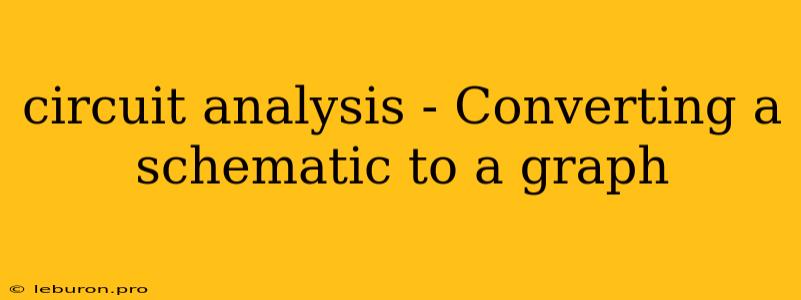Circuit analysis is a fundamental aspect of electrical engineering, involving the study of the behavior of electrical circuits. One crucial step in this process is converting a schematic diagram, a graphical representation of the circuit, into a graph. This transformation facilitates the application of powerful graph theory algorithms for analyzing the circuit's properties, such as finding its equivalent resistance, identifying paths and loops, and determining the circuit's stability. This article will delve into the process of converting a schematic to a graph, exploring the underlying principles and illustrating the conversion with a practical example.
Understanding the Conversion Process
The core principle behind converting a schematic to a graph lies in representing circuit elements as nodes and edges. Each component in the circuit, such as resistors, capacitors, inductors, and voltage sources, is represented by a node. The connections between these components are depicted as edges, signifying the flow of current or the existence of a potential difference.
From Schematic to Graph: A Step-by-Step Approach
-
Node Identification: Begin by identifying all unique nodes in the circuit. A node represents a connection point where multiple components meet. For instance, in a simple circuit with a resistor connected to a voltage source, there would be three nodes: one at the positive terminal of the voltage source, one at the negative terminal, and one at the junction point where the resistor connects to the source.
-
Edge Creation: For each connection between two nodes, create an edge in the graph. This edge represents the flow of current or the potential difference between the connected nodes. In the simple resistor-voltage source circuit example, there would be two edges: one connecting the positive terminal of the voltage source to the junction point and another connecting the junction point to the negative terminal of the voltage source.
-
Edge Labeling: Assign labels to each edge to represent the properties of the circuit element it corresponds to. For instance, a resistor edge would be labeled with its resistance value, while a voltage source edge would be labeled with its voltage value.
-
Graph Representation: Once all nodes and edges have been created and labeled, the resulting structure is the graph representation of the circuit. This graph can be visualized as a diagram with nodes as points and edges as lines connecting these points.
A Practical Example: Converting a Simple Circuit
Let's illustrate the conversion process with a simple example. Consider a circuit comprising a voltage source, two resistors, and a capacitor connected in series.
Schematic Diagram:
[Insert Schematic Diagram]
Graph Representation:
[Insert Graph Representation]
In this graph:
- Nodes: Node 1 (positive terminal of the voltage source), Node 2 (junction point between the voltage source and the first resistor), Node 3 (junction point between the first and second resistors), Node 4 (junction point between the second resistor and the capacitor), Node 5 (negative terminal of the voltage source).
- Edges:
- Edge 1: Connects Node 1 and Node 2, representing the voltage source (label: V).
- Edge 2: Connects Node 2 and Node 3, representing the first resistor (label: R1).
- Edge 3: Connects Node 3 and Node 4, representing the second resistor (label: R2).
- Edge 4: Connects Node 4 and Node 5, representing the capacitor (label: C).
Benefits of Circuit Graph Representation
Converting a schematic to a graph offers several advantages for circuit analysis:
- Simplified Representation: The graph provides a simplified representation of the circuit, eliminating the visual clutter of the schematic and highlighting the connections and relationships between components.
- Algorithm Application: Graph theory algorithms, such as shortest path algorithms, minimum spanning tree algorithms, and network flow algorithms, can be applied to the circuit graph to analyze its properties and behavior.
- Efficient Analysis: The graphical representation facilitates efficient analysis of the circuit's characteristics, such as its equivalent resistance, current distribution, and voltage drops across components.
Conclusion
Converting a schematic to a graph is a crucial step in circuit analysis, enabling the application of powerful graph theory algorithms to efficiently analyze the circuit's properties. By representing circuit components as nodes and connections as edges, the graph provides a simplified and structured representation, facilitating analysis and problem-solving. Understanding this conversion process empowers engineers to approach circuit analysis with a deeper understanding of the underlying relationships and behavior of electrical circuits.
